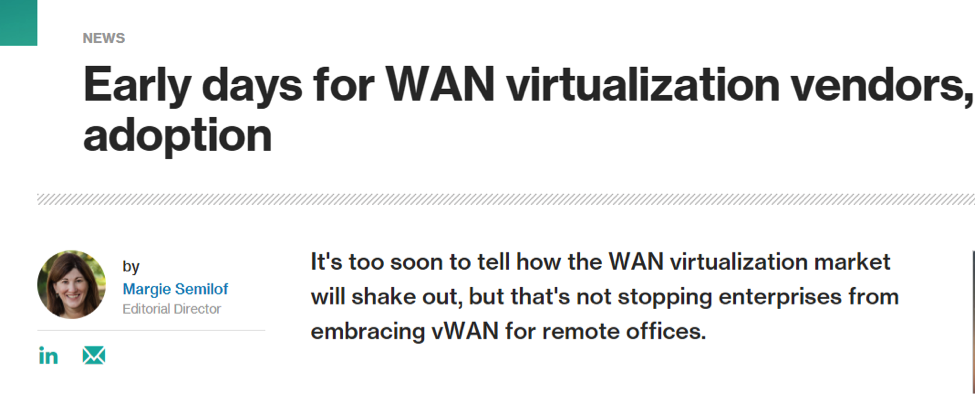 At the start of my PR career, a Businessweek reporter gave me some words of advice.
At the start of my PR career, a Businessweek reporter gave me some words of advice.
He said,
One company with a new technology isn’t news; two companies with the technology is a coincidence; three companies represent a trend.
The reporter’s words came back to me a few weeks ago when I spotted an article featuring a former client in a well-respected trade publication.
I decided to do some reverse engineering to determine what elements the story had in it that made it a success.
This article, “SD-WAN: What is it and why you’ll use it one day; An SDN for your branch office,” by Brandon Butler, ran in Network World.
For my former client’s sake, I was happy to see them so prominently featured in the story.
It had been one of their most coveted “media targets” back when I represented the client in 2014-15.
The placement, I’m sure, made their competitors envious.

The article tells a story about a company that had a problem and solved it with a new technology—that just so happens to be provided by my former client.
The reporter boosts the example of that one company through his use of statistics—from a well-known market research firm—about the astonishing rate at which other businesses are expected to adopt this emerging technology to solve their problems.
An analyst from that same research firm is quoted extensively for his expert opinion, of course.
The end of the article rounds up the also-mentioned companies, which sell similar solutions, thereby proving the “trend.”
As a sort of bonus, the reporter mentions survey results (from a competing vendor) that support the research firm’s findings.
Three Keys to a Successful PR Pitch
Voila! In this one tech article are the three keys to a successful PR pitch.
They are:
- A relatable story featuring a “poster child” that illustrates the trend
- Validation by an expert, preferably with credible statistics
- Names of other companies doing the same or similar things as the poster child
Can you use these ingredients more than once to get similar results with other trade publications?
Absolutely!
Here’s an example of a story my firm placed with a different high-domain-authority trade outlet when the client’s “emerging technology” was still in its infancy.

This SearchDataCenter article, Early days for WAN virtualization vendors, adoption, by Margie Semilof, contains the same three elements of all tech trend pieces, in slightly different order.
Read it and see if you can identify:
- Validation by an expert, with statistics
- Stories (about two companies in this article) that illustrate the trend
- Names of others doing the same or similar things
Five Do’s and Don’ts for a Successful PR Pitch
DO
Flesh out one customer case study so a reporter can use that as the lead-in to the story.
Many articles start with a look at one individual or organization and how things have changed with the use of new technology.
These anecdotes make trends more interesting and engaging to readers.
DON’T
Create a pitch around how many companies are using the new technology—that is too general.
DO
Support your overall PR pitch with market research data.
Reporters want to use research in their articles.
Research data lends itself to charts and graphs, and all content needs to have some artwork.
Create graphics and supply them with your pitch.
DON’T
Make sure the charts and graphs haven’t been used already by many media outlets.
Journalists want to have unique, fresh, new graphics.
DO
When you use your customer case study information to help tell your story, make sure you dig deep to get the real information on how and why they use your technology and what it’s doing for them.
Don’t accept the answer that all of their problems are solved.
Get specific answers.
Follow up every response a customer gives you with, “and what is the significance of that?”
DON’T
Don’t just use an already-written customer case study as the only source of your information.
Ask to speak to the client yourself or talk with a sales rep, a field engineer, or a customer-service person who knows the customer.
DO
List your competitors or alternative approaches to solving your technology problem.
Why?
A good reporter won’t leave that information out of a story.
Your competitors are not a secret.
Sometimes the company you keep gives you more credibility.
DON’T
Don’t be afraid to mention your competitors in your PR pitch.
If they are larger than your organization, but you are still successful in competing against them, that’s a plus for you.
DO
Help reporters generate more engagement with their articles.
Today’s journalists are measured and compensated on engagement, so help them out.
DON’T
Don’t forget to thank the reporter when the article is published.
Everyone likes to hear praise for their work and good manners are always appreciated!
Using these PR pitch examples, you can create trend story pitches for your clients or your company, no matter their industry.
So the next time you read an article and wonder how a particular company got covered while you didn’t, do a bit of reverse engineering to determine what the story had included in it to make it a success.